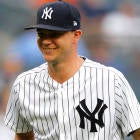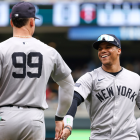In this glacially slow Hot Stove season, one team has bucked the trend by completely overhauling its pitching staff.
It's the same team that a few years ago broke an all-time record for most consecutive starts by rookie pitchers. The same team that ranked last, next-to-last, and fourth-to-last in the past three years by pitchers' Wins Above Replacement. The same team that not only acquired a passel of new arms but also replaced its manager, pitching coach, and bullpen coach, all part of an effort to transform its organizational culture and the way it develops its pitchers.
The Cincinnati Reds might be better this season, or they might be worse. But they sure as hell will be different.
On Oct. 31, the Reds announced they'd hired Derek Johnson to be their new pitching coach. Johnson had spent the previous three seasons in the same role with the Brewers, with tremendous results, including a 2018 season in which Milwaukee's pitchers finished fifth in the majors in ERA. Consider the starting pitchers who posted some of the best results -- journeyman soft-tossers like Jhoulys Chacin and Wade Miley -- and you see why the Reds were excited to poach Johnson from a division rival.
Cincinnati's new pitching coach might have better starting rotation raw material to work with than he did in Milwaukee too. In three separate moves this winter, the Reds acquired Alex Wood, Tanner Roark and Sonny Gray. Though even at their best all three pitchers fall at least a notch below the league's elite, Wood, Roark and Gray can claim two All-Star berths and three top-10 Cy Young finishes between the three of them.
Gray in particular presents a fascinating case study. An ultra-talented first-round pick back in 2011, the right-hander made good on his potential from day one in the big leagues, posting park-adjusted ERAs 46 percent, 20 percent, and 43 percent better than league average in his first three seasons, with a third-place finish in the 2015 AL Cy Young race. Granting that hindsight is 20/20, Oakland's history of trading good starting pitchers early in their careers after big seasons (Trevor Cahill, Gio Gonzalez, etc.) made you wonder if the A's might sell high after that 2015 campaign. Instead, Gray scuffled through a brutal, injury-plagued 2016, flashing a hideous 5.69 ERA in just 117 innings pitched. He managed to right the ship the next spring, pitching well enough for half a season to prompt a trade to the Yankees.
Since that trade, we've witnessed one of the most splits-dependent pitchers in the league go from Jekyll to Hyde depending on which mound he steps on.
- Gray at home in 2018: 59 1/3 IP, 78 H, 11 HR, 45 K, 35 BB, 6.98 ERA
- Gray the road in 2018: 71 1/3 IP, 60 H, 3 HR, 78 K, 22 BB, 3.17 ERA
Despite that extreme inconsistency, the Reds hotly pursued Gray, acquiring him in a trade with New York last month and immediately signing him to a three-year, $30.5 million contract extension. This despite Great American Ball Park playing as every bit the hitter-friendly bandbox that Yankee Stadium is, and Gray flashing warning signs back when he was still with Oakland. The Reds are bullish on his future nonetheless.
"Take a really deep dive into Sonny's numbers last year, they weren't as bad as what his normal numbers appear to be," said Johnson. He might have something there: Gray fell victim to a flukishly career-high .326 batting average on balls in play and a disproportionate number of bad innings, but still struck out nearly a batter an inning, with a lofty 50 percent groundball rate.
"I don't think there was any real question about his stuff," Johnson said. "It hadn't backed up, it was still the same. A pitcher struggles, he begins to reach for things, he struggles to know what to do next. I've known Sonny for a long time, I believe in him as a person, a pitcher, a teammate. I believe we can get him back to being who he was. I was around him when he was building that repertoire, building himself up as a player. Taking the risk of the extension shows how much we do believe in what he's able to do."
If Gray is the most unpredictable of the three new starting pitcher pickups, Roark is the most consistent. Throw out a 2016 season built largely on balls-in-play luck and an abnormally high strand rate, and and you have a pitcher who consistently prevents run at right around league-average rates, while averaging more than 190 innings pitched over the past three seasons. That durability should benefit the younger incumbent pitchers from last season's squad, said Reds rookie manager David Bell. Meanwhile, Wood has been the best pitcher of the three over the past couple years, clocking a strikeout-to-walk rate just shy of 4-to-1.
It's not just the arms that are new in Cincinnati, though. The revamped Reds coaching staff has been huddling throughout the winter, trying to hit the ground running ahead of the 2019 season. Talk to both Johnson and Bell, and each one shares a similar message about the other: They're aiming for as collaborative a process as possible, as the Reds try to shake off years of pitching misery.
"The most important thing we do is communicate," said Bell. "Yes, Derek has very strong thoughts and opinions. But one of the great things about Derek is he's not presenting a philosophy as much as sharing his expertise, as much as listening and contributing. Derek is smart enough to want to tap into some of the very smart people in this organization, and learn from them too. We are including everyone in the process, trying to be as aligned as possible."
Having Bell, Johnson, and multiple other coaches entering their first season with the Reds facilitates that less hierarchical, more collaborative approach. It could also help Cincinnati avoid overpreaching some of the oldest, least useful baseball slogans. On the pitching side, one such jingle is that nothing beats a well-placed fastball. While that might be true for many pitchers, a one-size-fits-all approach risks leaving certain pitchers behind.
When Gray tried to adopt the Yankees' approach of throwing fewer fastballs by featuring his four-seamer less often than ever before, he ran into trouble. On the flip side, young righty Luis Castillo threw heat (either his four-seamer or sinker) more than twice as often as he unleashed his changeup last season. That despite his changeup being one of the most devastating weapons in baseball (opponents batted .198 against it in 2018, and a microscopic .124 against it during Castillo's electric rookie season). The Reds' only pitching philosophy this season will be not to have one, but instead to customize instruction based on whoever's standing on the mound.
"I use Wade (Miley) as an example," said Johnson, referring to his work with journeyman turned shutdown pitcher Wade Miley for the Brewers last season. "Wade came into camp, having spent a lot of time in that offseason trying to figure out how to be a better pitcher. He understood some of his limitations, understood he needed to make some changes. So we worked with him on those changes, on trying to convey to guys what their individual strengths really are. All of baseball is built around relationships, on getting guys to the point where we can have a dialogue, and some real thought behind the dialogue. You want pitchers to be invested, and be part of that development. You talk through things, get one another's opinions, and then it's OK to be wrong and start over too."
The hope is that an individualized approach will get the best out of the three veteran imports and maybe more importantly unlock more of Castillo's huge potential, as well as the upside of numerous other young Reds pitchers.
"You'd like to be able to point to just one thing and say 'that's going to be it,'" said Johnson. "I think in Castillo's case, he's very talented, he's got a pitch that's very hard to hit. Then the other part of him and some of the other guys on the staff, which is normal for their age, is figuring out the rest of it. He's got to be able to put his changeup in the zone when he wants to, and also be able to take it out of the strike zone at the right time. I think more than anything it's just getting more experience at this level. At High-A and Double-A, guys swing at pitches that they won't in the big leagues. So you have to figure out, 'What's my next step as a pitcher? What can I do to help get lefties out a little more?' It's figuring out what a hitter's trying to do, what they'll swing at, what they won't. It's learning how to pitch. And when it happens, it's going to be really awesome to watch."
Awesome to watch if and when it happens, and promising for a team coming off five straight sub-.500 seasons. If the Reds finally get the quality pitching they've long sought, the team with an elite set of corner infielders, a strong group of prospects that includes major-league-ready hitter Nick Senzel, and new faces like Yasiel Puig and Matt Kemp, suddenly becomes one of baseball's most intriguing sleepers.






















